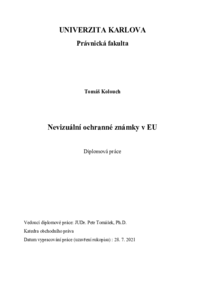Nevizuální ochranné známky v EU
Non-visual trade marks in EU
diplomová práce (OBHÁJENO)

Zobrazit/
Trvalý odkaz
http://hdl.handle.net/20.500.11956/170833Identifikátory
SIS: 227796
Kolekce
- Kvalifikační práce [14446]
Autor
Vedoucí práce
Oponent práce
Patěk, Daniel
Fakulta / součást
Právnická fakulta
Obor
Právo
Katedra / ústav / klinika
Katedra obchodního práva
Datum obhajoby
25. 11. 2021
Nakladatel
Univerzita Karlova, Právnická fakultaJazyk
Čeština
Známka
Výborně
Klíčová slova (česky)
nevizuální ochranné známky, ztvárnění, Evropská unieKlíčová slova (anglicky)
non-visual trade marks, representation, European UnionNevizuální ochranné známky představují relativně nový fenomén na poli ochranných známek, jehož prostřednictvím se podnikatelé snaží originálním způsobem odlišit své výrobky nebo služby od výrobků nebo služeb svých konkurentů. Řadíme zde čtyři druhy netradičních ochranných známek, které jako takové nelze vnímat vizuálně, nýbrž prostřednictvím jiných lidských smyslů než zraku: zvukové, čichové, chuťové a hmatové ochranné známky. Ačkoli tyto nevizuální ochranné známky mohou při registraci čelit mnoha překážkám, je tato práce vzhledem ke svému omezenému rozsahu zaměřena na kritérium ztvárnění v rejstříku ochranných známek, jelikož tento požadavek vyvolává s ohledem na jejich nevizuální povahu specifické obtíže. Cílem této práce je tedy posoudit nevizuální ochranné známky z hlediska jejich způsobilosti být adekvátně ztvárněny v rejstříku ochranných známek v EU. Práce je rozdělena do tří kapitol. První kapitola se zaměřuje na vymezení pojmu nevizuálních ochranných známek, jejich význam, funkce a rovněž definiční znaky, především pak na požadavek ztvárnění ochranných známek v rejstříku ochranných známek. Druhá kapitola se nejprve věnuje vývoji mezinárodních snah o částečnou harmonizaci požadavků na ztvárnění nevizuálních ochranných známek, následně pak i genezi právní úpravy na úrovni EU s důrazem na tzv....
Non-visual trade marks represent a relatively new phenomenon in the field of trade marks, through which entrepreneurs try to differentiate their goods or services in an original way from the goods or services of their competitors. These include four types of non-traditional trade marks, which as such cannot be perceived visually, but through human senses other than sight: sound, olfactory, taste and tactile trade marks. Although these non-visual trade marks may face many barriers to registration, the thesis, because of its limited scope, focuses on the criterion of representation on a trade mark register, as this requirement raises specific issues due to their non-visual nature. The aim of the thesis is therefore to assess non-visual trade marks in terms of their capability to be adequately represented on a trade mark register in the EU. The thesis is divided into 3 chapters. The first chapter focuses on the definition of non- visual trade marks, their purpose, functions and also defining features, especially on the requirement for representation of trade marks on a trade mark register. The second chapter first deals with the development of international efforts to partially harmonize the requirements for representation of non-visual trade marks and subsequently with the genesis of legislation at...
